Last updated 26 February 2023
DORNIER DO 24 IN AUSTRALIACompiled by Geoff Goodall
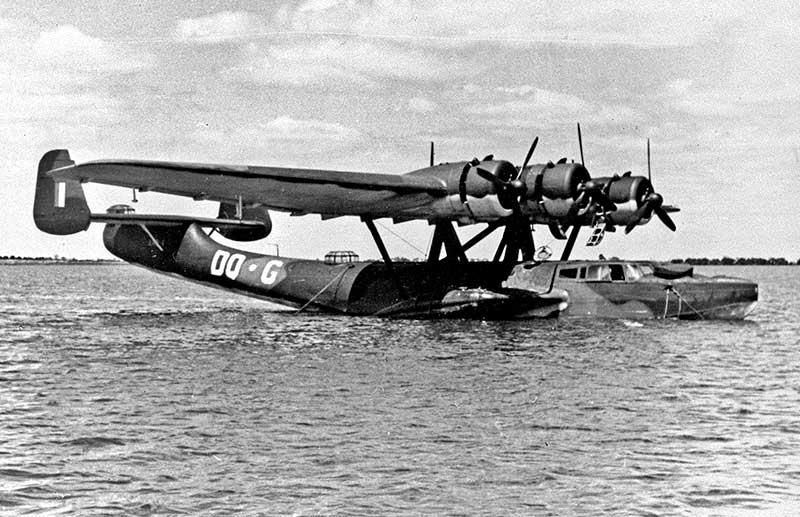
Photo: John Hopton Collection
The first six were shipped to the NEI from November 1937 and entered service with serials X-1 to X-6. MLD ordered a further 18 aircraft for Dornier. A licence was negotiated for Dutch production of the type by Aviolanda but delays caused another six to be purchased from Dornier's Swiss subsidiary AG fur Dornier-Flugzeuge at Altenheim (X-25 to X-29 and X-37).
Because of their allocated serial numbers, the Do 24s were referred to as X-Boats, and the large MLD orders for Catalinas became the Y-Boats. A total of 37 Do 24s were received in NEI before the order for another 37 from Aviolanda at Papendrecht, Netherlands was cut by the German occupation of The Netherlands in May 1940. The Aviolanda production was delivered to the Luftwaffe.
Later in February 1942 MLD Dornier and Catalinas were regular arrivals on Roebuck Bay at Broome crammed with up to 30 civil and military personnel fleeing the NEI. NEI and US military transports and bombers as well as NEI airliners were arriving at Broome airfield also carrying refugees. By the end of February in Australia, a hastily-organised airlift of all available transport aircraft were diverted to Broome to collect the NEI escapees and fly them to hospitals in Perth, Alice Springs and east coast cities.
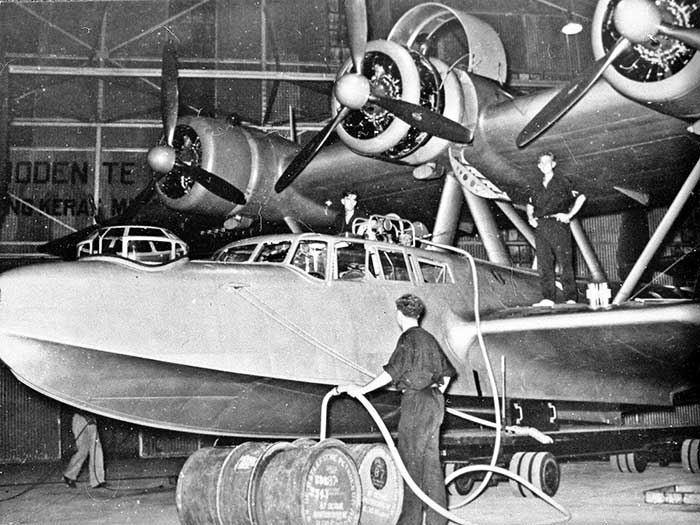
Photo: John Hopton Collection
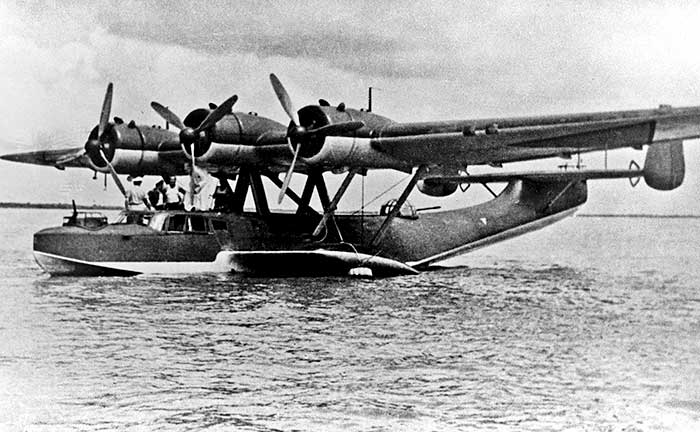
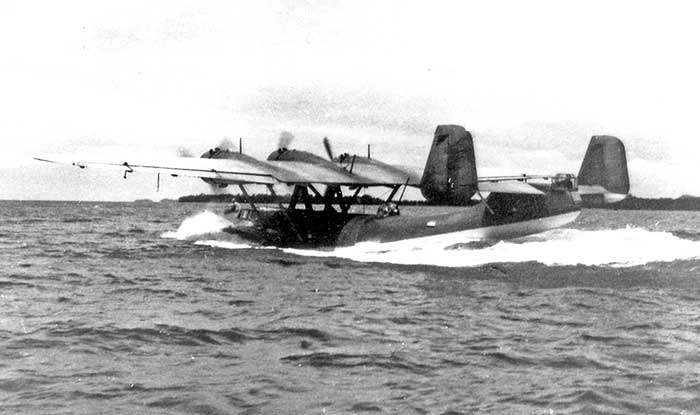
A crew member can be seen as nose observer. Photo: Richard E. Hourigan collection
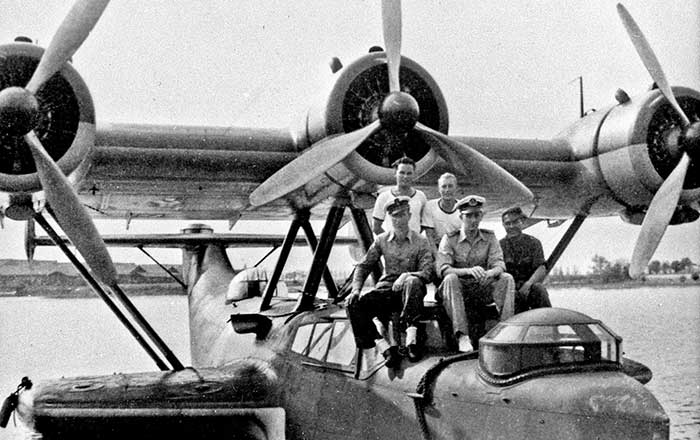
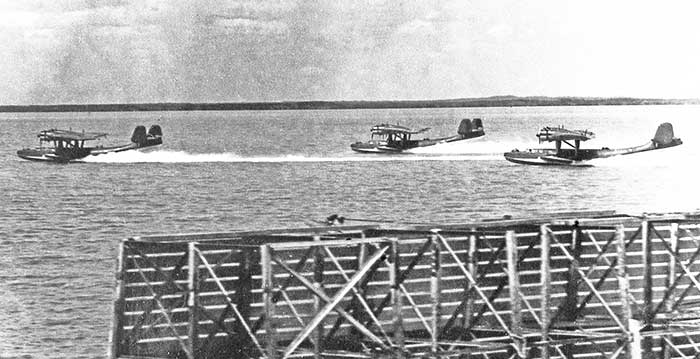
structure in the foreground was erected for Qantas in 1939 to protect their Empire flying boat mooring jetty.
This RAAF photograph is labelled as showing RAAF Do-24s, however the reality was that three RAAF
Dorniers were never serviceable at the same time. Photo: Australian War Memorial
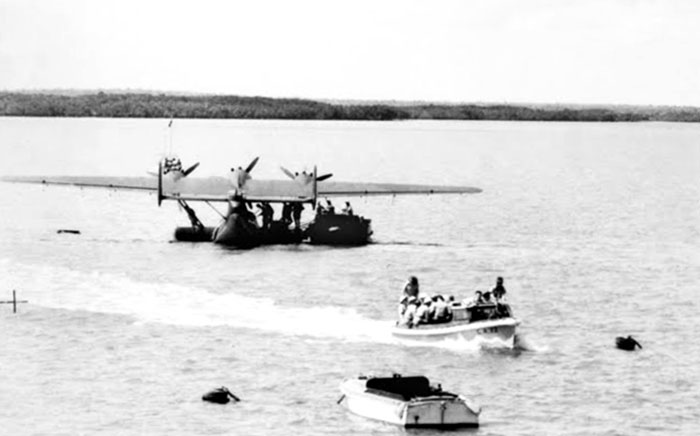
Photo: Australian War Memorial
Tragedy at Broome
In 1942 Broome was a small coastal fishing and pearling
town in the remote
tropical far north of Western Australia. The town airfield was used by
MacRobertson Miller Aviation Company's long-haul airline service
between Perth and Darwin using Lockheed 10B Electras. Broome was
located on Roebuck Bay, a wide expanse of calm waters with a remarkable
daily tidal variation of up to 10 metres. At low tide the pearling
lugger fleet settled on the sandy bottom.
In late February 1942 during the frantic days of Japanese forces advancing through the NEI, Dutch flying boats began arriving at Broome carrying refugees fleeing the Japanese in NEI. The Australian Government requested Qantas Empire Airways to operate its Short S.30 Empire flying boats on an evacuation service for retreating military and civilian personnel from NEI to Australia. Broome was chosen as the Australian terminal because no other northwest WA coastal town offered the sheltered water of Roebuck Bay, despite the complete lack of facilities for flying boats. Broome's extreme daily tidal variation would make refuelling difficult and laborious. The Qantas Tjilijap Shuttle commenced 22 February between the port of Tjilijap in Java and Broome. The predicted problems made fast turn-arounds at Broome an impossibility, with a single refuelling lugger which could only take on fuel at the short jetty at high tide.
Adding to the activity at Broome airfield from late February were the civil and military aircraft of the Australian airlift to collect the NEI escapees and fly them to hospitals in Perth, Alice Springs and east coast cities. Among them was a USAAC C-53 41-20066 (troop-carrier model of the C-47) only just arrived in Australia from its delivery flight from USA. It crew were instructed to proceed from Perth to Broome on 26 February but became lost in the dark and made a forced landing in scrub north of Derby WA with no injuries.
In the first days of March 1942, most of the Australian civilian residents of Broome had been evacuated and numerous civil and military aircraft were arriving from the NEI at Broome airfield and flying boats on Robeuck Bay, most carrying refugees which included many British and Dutch women and children. In addition the military retreat included USAAC B-17s, B-18s and B-24s which had escaped the Philippines through the Netherlands East Indies.
By the morning of 3rd March, a total of 15 flying boats were moored on Roebuck Bay:
Catalinas: Dutch: Y-59, Y-60, Y-67, Y-70, US Navy: 2 PBY-4s, RAF: 2 Catalinas 205 squadron
Dornier Do 24s: Dutch: X-1, X-3, X-20, X-23, X-28
Short Empires: Qantas G-AEUC Corinna, RAAF A18-10 ex Qantas
Early that morning, 9 Japanese A6M Zeros and a C5M Babs recce aircraft arrived overhead from Japanese occupied Timor and commenced staffing attacks on the flying boats and aircraft at Broome airfield. All flying boats were sunk with the loss of most of their occupants including women and children. A USAAC Liberator packed with sick and wounded servicemen took off from the airfield but was quickly shot down into the sea off Cable Beach, killing 32 men. A US Navy Curtiss SOC Seagull floatplane took off from the water and managed to escape and a USAAC Douglas C-53 departed the airfield minutes before the raid, carrying 26 civilian Dutch refugees plus babies in arms, to Alice Springs then Melbourne.
Destroyed at Broome airfield were:
B-17E: USAAC 41-2448, 41-2454
B-24A: USAAC 40-2370, 40-2374 shot down after takeoff
Hudson RAAF A16-119
Lodestar Dutch LT9-18
DC-3 KNILM PK-ALO
When the Japanese fighters at Broome formed up to return to Timor, they spotted another inbound KNILM Douglas DC-3 PK-AFV, which was painted in camouflage. They straffed the DC-3, injuring five of the evacuees on board. Captain Ivan Smirnov, wounded in an arm, took evasive action for some time but with an engine on fire make a successful wheels-up landing on a beach at Carnot Bay, 70 Km north of Broome. Soon after, a Japanese Mavis flying boat approached and circled the DC-3, dropping 5 bombs which caused no injury. However a Dutch lady passenger and her young child died on the beach and wounded Dutch servicemen needed urgent help. The story of their rescue and the search for the consignment of diamonds stolen from the aircraft has been told in many magazine and newspaper articles.
Fortunately the Japanese fighters did not sight an inbound Qantas Empire G-AEUB Camilla which arrived an hour after the raid.
Another Dornier "X Boat" was inbound from NEI to Broome the previous night, with a remarkable 30 refugees on board, most sitting on mattresses in the main cabin. X36 was commanded by Captain Petsu, who made a night landing on the sea off the WA coastline when he was unable to locate Broome. Their location was 150 miles south of Broome on a remote beach of Anna Plains cattle station. At daybreak next morning, the tide went out leaving the Dornier in shallow water, allowing the occupants to walk to the beach. A few hours later they were seen from MMA's Lockheed 10B Electra VH-ABW flown by MMA chief pilot Captain James Woods, who had departed Broome for Port Hedland carrying 22 casualties packed into his 10 passenger Lockheed. Woods circled the party on the beach while they wrote messages in the sand then landed at the Anna Plains Station homestead to tell the staff of the Dornier and its occupants. Ground parties from the homestead set off with water and supplies. When they were rescued, Captain Petsu ordered his crew to pour oil over the mattresses in the cabin and set the Dornier on fire rather than let it fall into Japanese hands.
On the same morning, another group of 8 Zeros had left Timor to attack Wyndham, further north, where a RAAF DH.84 Dragon A34-9 and Airlines (WA) Ltd Stinson Reliant VH-UTW on the ground at the airfield were also destroyed. Broome later received three more Japanese air raids, but none of the severity of this first attack. The detailed story of the raid and the human toll is beyond the scope of this paper, but the following books are recommended reading:
- Qantas At War, Sir Hudson Fysh, Angus & Robertson 1968
- Front-Line Airline, E. Bennett-Bremner, Angus & Robertson 1944
- Zero Hour in Broome, Dr. Tom Lewis & Peter Ingman, 2012
- Departure Delayed, Jan van Apeldoorn, Robertson & Mullens, 1943
- Jimmy Woods, Flying Pioneer, Julie Lewis, Fremantle Arts Centre Press, 1989
After the Broome raid of 3 March 1942, evacuation aircraft continued to arrive from NEI over the following week, including RAF Hudson AE488, KNIL Lodestars and KNIL Martin bomber M585. The final Catalina arrival was on 7 March, Dutch "P-3"which had been a damaged US Navy PBY-3 repaired by MLD ground crews and commandeered by a MLD aircrew.
The final Dornier Do 24 departure from NEI was X-24 on 8 March, heading for Broome. Low of fuel, it landed in the sea at Wallal, 200 miles south of Broome, and after arranging refuelling flew on to Perth and Rathmines.
See also on this Website: Kimberley War Relics
In late February 1942 during the frantic days of Japanese forces advancing through the NEI, Dutch flying boats began arriving at Broome carrying refugees fleeing the Japanese in NEI. The Australian Government requested Qantas Empire Airways to operate its Short S.30 Empire flying boats on an evacuation service for retreating military and civilian personnel from NEI to Australia. Broome was chosen as the Australian terminal because no other northwest WA coastal town offered the sheltered water of Roebuck Bay, despite the complete lack of facilities for flying boats. Broome's extreme daily tidal variation would make refuelling difficult and laborious. The Qantas Tjilijap Shuttle commenced 22 February between the port of Tjilijap in Java and Broome. The predicted problems made fast turn-arounds at Broome an impossibility, with a single refuelling lugger which could only take on fuel at the short jetty at high tide.
Adding to the activity at Broome airfield from late February were the civil and military aircraft of the Australian airlift to collect the NEI escapees and fly them to hospitals in Perth, Alice Springs and east coast cities. Among them was a USAAC C-53 41-20066 (troop-carrier model of the C-47) only just arrived in Australia from its delivery flight from USA. It crew were instructed to proceed from Perth to Broome on 26 February but became lost in the dark and made a forced landing in scrub north of Derby WA with no injuries.
In the first days of March 1942, most of the Australian civilian residents of Broome had been evacuated and numerous civil and military aircraft were arriving from the NEI at Broome airfield and flying boats on Robeuck Bay, most carrying refugees which included many British and Dutch women and children. In addition the military retreat included USAAC B-17s, B-18s and B-24s which had escaped the Philippines through the Netherlands East Indies.
By the morning of 3rd March, a total of 15 flying boats were moored on Roebuck Bay:
Catalinas: Dutch: Y-59, Y-60, Y-67, Y-70, US Navy: 2 PBY-4s, RAF: 2 Catalinas 205 squadron
Dornier Do 24s: Dutch: X-1, X-3, X-20, X-23, X-28
Short Empires: Qantas G-AEUC Corinna, RAAF A18-10 ex Qantas
Early that morning, 9 Japanese A6M Zeros and a C5M Babs recce aircraft arrived overhead from Japanese occupied Timor and commenced staffing attacks on the flying boats and aircraft at Broome airfield. All flying boats were sunk with the loss of most of their occupants including women and children. A USAAC Liberator packed with sick and wounded servicemen took off from the airfield but was quickly shot down into the sea off Cable Beach, killing 32 men. A US Navy Curtiss SOC Seagull floatplane took off from the water and managed to escape and a USAAC Douglas C-53 departed the airfield minutes before the raid, carrying 26 civilian Dutch refugees plus babies in arms, to Alice Springs then Melbourne.
Destroyed at Broome airfield were:
B-17E: USAAC 41-2448, 41-2454
B-24A: USAAC 40-2370, 40-2374 shot down after takeoff
Hudson RAAF A16-119
Lodestar Dutch LT9-18
DC-3 KNILM PK-ALO
When the Japanese fighters at Broome formed up to return to Timor, they spotted another inbound KNILM Douglas DC-3 PK-AFV, which was painted in camouflage. They straffed the DC-3, injuring five of the evacuees on board. Captain Ivan Smirnov, wounded in an arm, took evasive action for some time but with an engine on fire make a successful wheels-up landing on a beach at Carnot Bay, 70 Km north of Broome. Soon after, a Japanese Mavis flying boat approached and circled the DC-3, dropping 5 bombs which caused no injury. However a Dutch lady passenger and her young child died on the beach and wounded Dutch servicemen needed urgent help. The story of their rescue and the search for the consignment of diamonds stolen from the aircraft has been told in many magazine and newspaper articles.
Fortunately the Japanese fighters did not sight an inbound Qantas Empire G-AEUB Camilla which arrived an hour after the raid.
Another Dornier "X Boat" was inbound from NEI to Broome the previous night, with a remarkable 30 refugees on board, most sitting on mattresses in the main cabin. X36 was commanded by Captain Petsu, who made a night landing on the sea off the WA coastline when he was unable to locate Broome. Their location was 150 miles south of Broome on a remote beach of Anna Plains cattle station. At daybreak next morning, the tide went out leaving the Dornier in shallow water, allowing the occupants to walk to the beach. A few hours later they were seen from MMA's Lockheed 10B Electra VH-ABW flown by MMA chief pilot Captain James Woods, who had departed Broome for Port Hedland carrying 22 casualties packed into his 10 passenger Lockheed. Woods circled the party on the beach while they wrote messages in the sand then landed at the Anna Plains Station homestead to tell the staff of the Dornier and its occupants. Ground parties from the homestead set off with water and supplies. When they were rescued, Captain Petsu ordered his crew to pour oil over the mattresses in the cabin and set the Dornier on fire rather than let it fall into Japanese hands.
On the same morning, another group of 8 Zeros had left Timor to attack Wyndham, further north, where a RAAF DH.84 Dragon A34-9 and Airlines (WA) Ltd Stinson Reliant VH-UTW on the ground at the airfield were also destroyed. Broome later received three more Japanese air raids, but none of the severity of this first attack. The detailed story of the raid and the human toll is beyond the scope of this paper, but the following books are recommended reading:
- Qantas At War, Sir Hudson Fysh, Angus & Robertson 1968
- Front-Line Airline, E. Bennett-Bremner, Angus & Robertson 1944
- Zero Hour in Broome, Dr. Tom Lewis & Peter Ingman, 2012
- Departure Delayed, Jan van Apeldoorn, Robertson & Mullens, 1943
- Jimmy Woods, Flying Pioneer, Julie Lewis, Fremantle Arts Centre Press, 1989
After the Broome raid of 3 March 1942, evacuation aircraft continued to arrive from NEI over the following week, including RAF Hudson AE488, KNIL Lodestars and KNIL Martin bomber M585. The final Catalina arrival was on 7 March, Dutch "P-3"which had been a damaged US Navy PBY-3 repaired by MLD ground crews and commandeered by a MLD aircrew.
The final Dornier Do 24 departure from NEI was X-24 on 8 March, heading for Broome. Low of fuel, it landed in the sea at Wallal, 200 miles south of Broome, and after arranging refuelling flew on to Perth and Rathmines.
See also on this Website: Kimberley War Relics
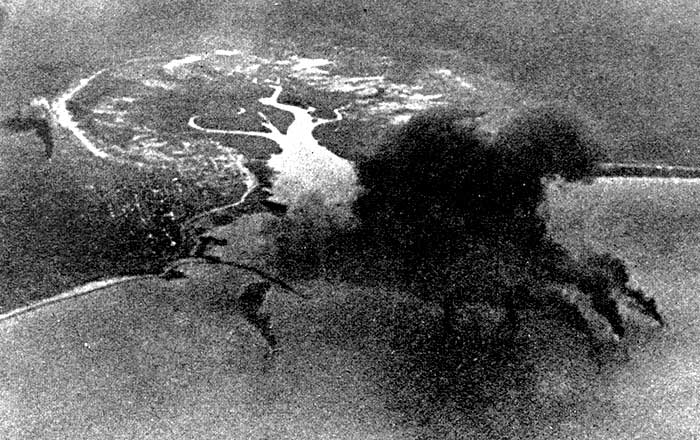
land planes burning on the airfield to the left behind the town. Photograph taken from the reconnaisance
Mitsubishi C5M Babs which accompanied the Zeros from Timor. David Vincent collection
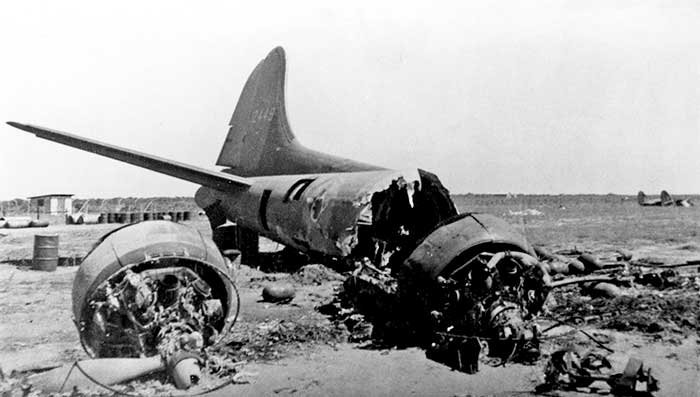
of a Lockheed, either RAAF Hudson A16-119 or NEI Lodestar LT9-19 Frank F. Smith collection
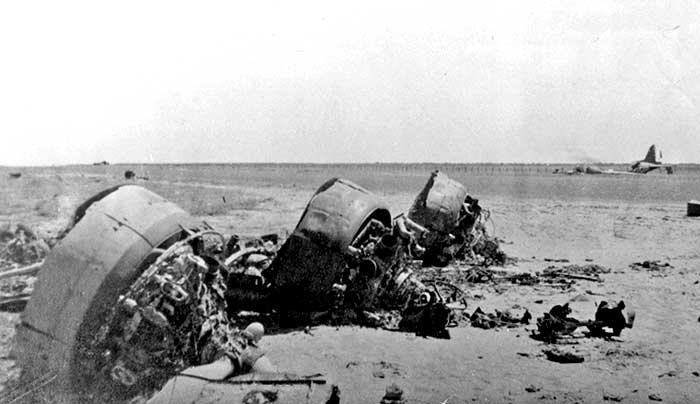
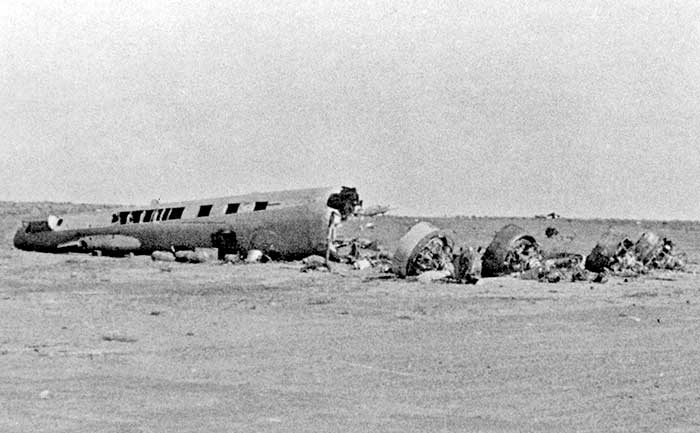
B-17E 41-1448 some time later, after a USAAC team had removed the undamaged complete tailplane unit
forward of the rear turret, to be used as salvaged spare parts. David Vincent collection
forward of the rear turret, to be used as salvaged spare parts. David Vincent collection
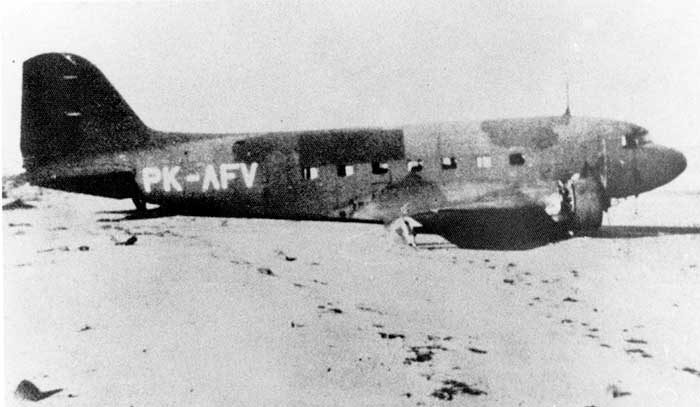
and made a forced-landing on a beach at Carnot Bay, 70 Km north of Broome.
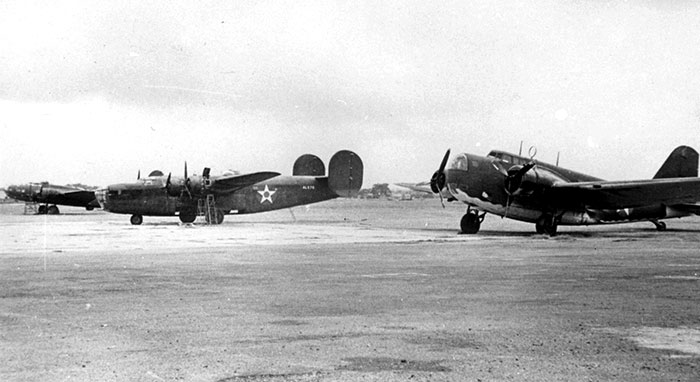
They had escaped the Philippines via NEI and missed the Broome raid. Geoff Goodall collection
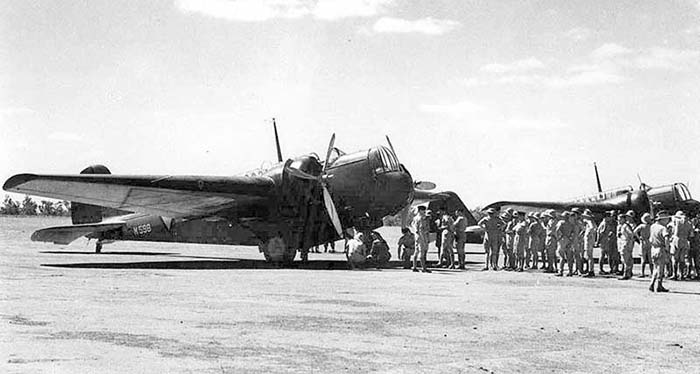
ML-KNIL (NEI Air Force) still had six squadrons of this export variant of the USAAC Martin B-10 at the time
of the Japanese invasion. This picture shows two Dutch Martin 139WHs visting Darwin in May 1941.
Charles Eaton Photograph Collection via Mitch Williamson: http://www.ozatwar.com
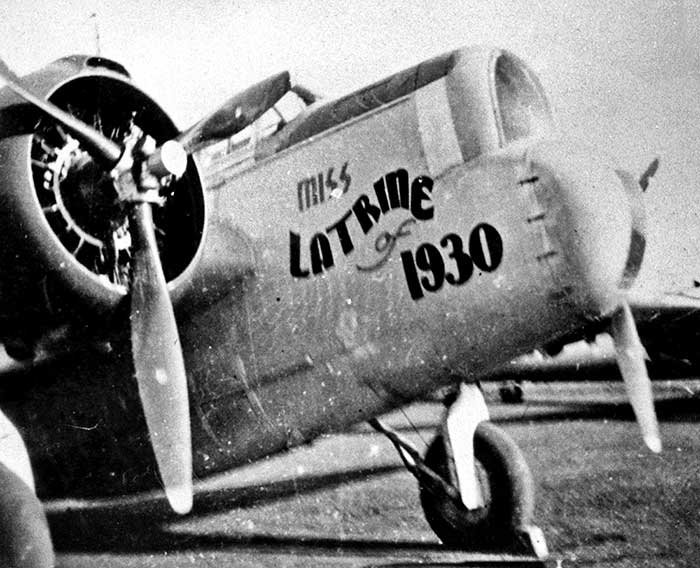
Given temporary USAAC serial 42-68358, the nose art reflects the US crews' opinion of the veteran bomber.
Photo: David Vincent collection
Five other MLD Dorniers X-5, X-7, X-8, X-9, X-10 were flown to
Australia in February 1942 as part of a MLD retreat to set up a
training base in Australia. These were among the earliest delivered
and were in poor condition. Five days after the Broome attack,
the last Dornier evacuation flight from the NEI was X-24 on 8 March
1942, while made landfall at Wallal WA, 200 miles south of Broome. The
crew managed to arrange refuelling in this remote location and
continued to Perth. These six Dorniers made their way to
RAAF Rathmines on Lake
Macquarie NSW, where the remnants of the Dutch
naval aviation forces had re-grouped as MLD Rathmines Unit (Afdeling MLD Rathmines). This camp had been formed by personnel from the
Ryan STM floatplane squadrons as a Dutch training camp on the
RAAF station. A total of 37 Ryans and their airmen had been shipped to Australia in
February 1942 from Sourabaya ahead of the Japanese advance. A number of
these Ryan floatplanes were assembled at Rathmines by the end of
the following month, and wearing their MLD paint schemes and serials,
were being flown for training by the Dutch pilots.
MLD cadet pilot Hans de Vries later wrote:
"In February 1942 we escaped by ship from the Dutch East Indies to Australia, landing at Fremantle. I was lucky as, from the three ships that started out, two got torpedoed and only one made it to Australia. The Netherlands Naval Air Force personnel were located at Rathmines on Lake Macquarie NSW where for two months we continued our flying training on the water and we were integrated with RAAF personnel and issued with RAAF uniforms. We flew the Ryan STM on floats. In April 1942 we were transferred to USA where we reverted to our own Dutch uniforms and were trainined by American instructors."
MLD cadet pilot Hans de Vries later wrote:
"In February 1942 we escaped by ship from the Dutch East Indies to Australia, landing at Fremantle. I was lucky as, from the three ships that started out, two got torpedoed and only one made it to Australia. The Netherlands Naval Air Force personnel were located at Rathmines on Lake Macquarie NSW where for two months we continued our flying training on the water and we were integrated with RAAF personnel and issued with RAAF uniforms. We flew the Ryan STM on floats. In April 1942 we were transferred to USA where we reverted to our own Dutch uniforms and were trainined by American instructors."
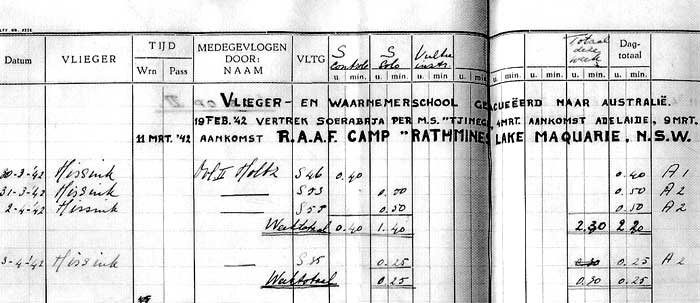
Courtesy: The Collection.
and the Indonesian airmen who flew them, I have attached a picture of the Dornier in our bay - you can see our boat shed in the background. The airmen who were based here in a house at the point were thought of very highly by our family. My father, a professional fisherman, would trade fresh fish for aviation fuel to run his generator, they would often come down for meals. When they left, they gave my grandmother a going-away gift of a crystal vase, which is still in the family."
The dates and circumstances of this Dornier detachment to Mannering Park are interesting, conflicting with Phil Mathieson's account of the Dorniers' arrival at Rathmines in the next section.
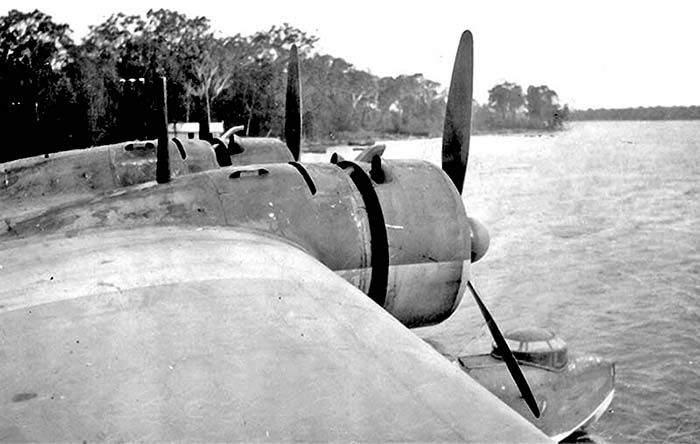
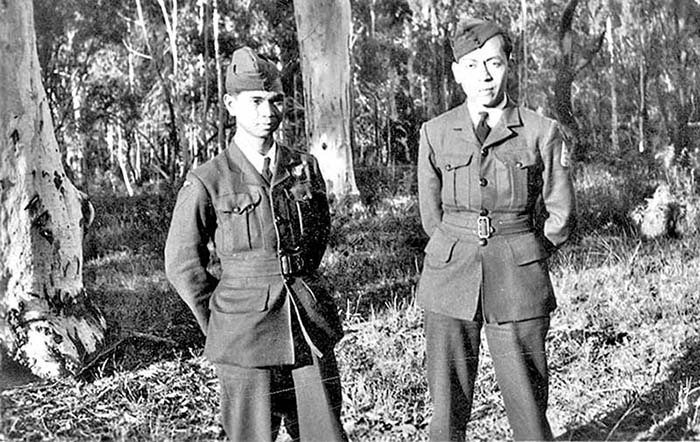
The six Dutch Dorniers had arrived at Rathmines in early March. 41 Squadron pilot Philip Mathiesen recalls the period:
"These Dorniers had been used for evacuations, up rivers and lakes where they hit logs, and they were terribly knocked about by the time they got to Rathmines. They arrived with no beaching gear or equipment and they were just run up in the mud by the edge of the lake near the RAAF station and stayed there for months, just sitting part in and out of the water. Their hulls had been holed and patched by pouring concrete into them. They were in a terrible state. Then the RAAF took them over and it meant a complete stripping of all the electric wiring and replating of the hulls. It was a major repair job." 2
No.2 Flying Boat Repair Depot at Rathmines was tasked with preparing the first Dorniers for RAAF service. 2FBRD Commanding Officer was popular Wing Commander G.U. Scotty Allan, prewar pioneer aviator and experienced Qantas flying boat Captain.
RAAF Squadron Leader Bryan Monkton with No.41 Townsville, then flying Short C Class flying boats seconded from Qantas, described in his biography The Boats I Flew being sent from Townsville to Rathmines in December 1942 with fellow pilot Michael Mather and 20 engineers to collect their first two Dorniers. Because of their poor condition, lack of spares or even factory manuals, the overhauls were behind schedule. Even the American Wright Cyclone engines presented problems to overhaul because they were discontinued model R-1830-F52s for which spare parts were difficult to acquire. Monkton wrote:
"Eventually the first Dornier was rolled out of the hangar on an improvised beaching trolly and lowered down the slipway into the water. It was then that we saw this aircraft in its true perspective. I had always likened the Empire flying boat to a great ocean liner, however the Dornier was a machine of war. Sadly we saw that the guns and cannon had been removed and tie-down rings installed in the various compartments for the carriage of cargo. Now it was just another transport aircraft. Scotty Allan and his crew took the Dornier on its test flight and we all lined the shore to witness the event. Scotty brought the Dornier back over the station at about 200 feet several times and there was no doubt its appearance, in dull black and grey camouflage paint, was distinctly purposeful and sinister.
We were soon flying the Dornier on training exercises every day and sometimes at night to familiarise ourselves with this strange aircraft. Not only were the instruments and controls different from those we had been accustomed to in British aircraft, but they were still labelled in German. One of the unusual features of the Dornier was the absence of wing-tip floats. Instead the Dornier had stubby wing-like protruberances, called sponsons, on each side of the hull at water level." 3
During February 1943, the second Do 24K completed its overhaul at Rathmines and Monkton ferried the first from Rathmines to No.41 Squadron at Townsville, leaving Mather at Rathmines to carry out training in A49-2. Phil Matheson describes his experiences:
"Then we got the Dornier A49-2 out on the water and proceeded to taxy it around to see how it responded. Finally we got to flying it, to find out how the thing went. It was very interesting. It was quite a change from the Empire boat where you were sitting fairly high out of the water. With the Dornier you could reach out through the cockit windoiw and touch the water. They were very, very strong aircraft but what I didn't like about them was the hull was somewhat reminiscent of a submarine. It was a low tubular fuselage and you went down into it through a round hatch which clanged shut and and the crew screwed tight bolts all the way around it. We used to put 40 troops aboard." 2
1. Hans de Vries, interviewed by Jim Skyring, Aerogram magazine, March 2010
2 Phil Matheson interviewed by Greg Banfield in 1967, published in Man and Aerial Machines journal, March-April 1996.
3. Bryan Monkton, The Boats I Flew, Australian Aviation Museum, Bankstown, 2005
RAAF Lake Boga
Other
Dorniers were sent to No.1 FBRD at Lake Boga close to the River Murray
in northern Victoria to have their pre-RAAF overhauls. Until then this
unit had been mostly servicing RAAF Catalinas and Walrus seaplanesFirst were A49-3 and A49-5, which were ferried together from Rathmines, touching down on the calm waters of Lake Boga on 2 September 1942 after 4hrs 20 mins flying time. Maintenance proved difficult just like at Rathmines and it was nine months before they were both test flown in June 1943. The pair were then ferried to Townsville to join No.41 Squadron. Only weeks later 41 Squadron CO grounded A49-3 and -5, stating that their persistent electrical faults made them a fire risk. They were ferried back to Lake Boga.
After this disappointing start, 1FBRD settled down to carrying out a range of repairs and overhauls on the RAAF Dorniers, taking overe the majority of such work from 2FBRD at Rathmines. As the war progressed, large numbers of RAAF Catalinas and Mariners arrived for maintenance as well as USAAC and USN Catalinas. As the workload at Lake Boga grew, Wing Commander G.U. Allan was posted as CO from his previous position as CO of 2FBRD Rathmines. His experience with maintenance and flying the Do 24Ks would have been a bonus for Lake Boga because there were still no spares and most oparts had to be improvised.
This following three pictures, courtesy David Vincent's collection, show the poor condition of one of the early Dornier arrivals at Lake Boga, either A49-3 or A49-5. Its Dutch Navy paintwork with the Netherlands small triangle nationality emblem is faded and peeling from long exposure to the elements. 1FBRD's hard standing areas for maintenance on land had not yet been completed so the Dornier was nosed into a rough pen dug in the lake edge to allow the overhaul to begin.

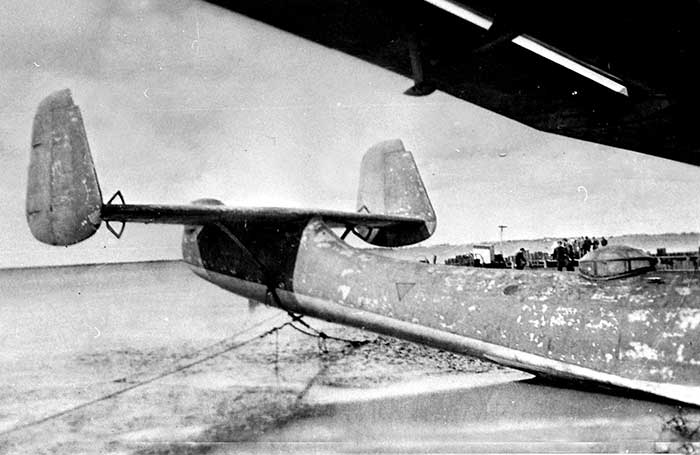
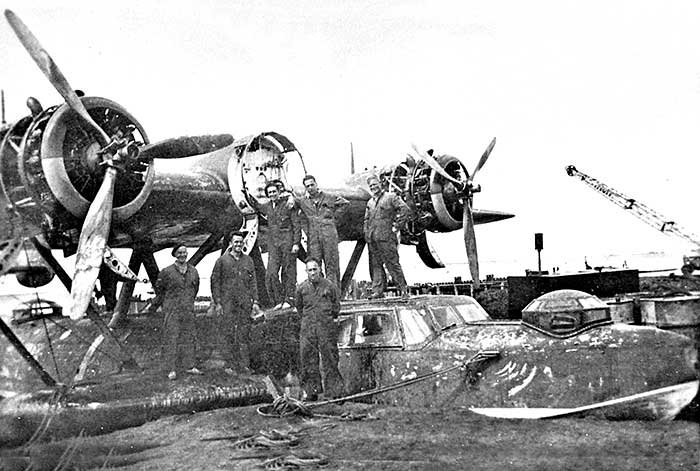
Dorniers in RAAF service
41 Sqn's Dorniers had a poor serviceability record as revealed in their individual histories below.
As more Catalinas and then Martin Mariner flying boats were delivered across the Pacific to RAAF, the Dorniers were retired in the first half of 1944, most having flown only a year in Australian service. Among ongoing maintenance problems, there was a specific reason for their early withdrawal. Brian Monkton wrote:
"The Dornier had a serious problem caused by the sponsons. These wing-like floats also served as auxiliary fuel tanks. Due to the pounding they received in the rough seas at some places, cracks developed in the division between the sponsons and the hull allowing fuel to leak through. It was not unusual to have several gallons of high-octane fuel sloshing about under the compartment floors where troops were being carried. Naturally we were terrified that, despite the dire warnings given at pre-flight briefings, someone would light a cigarette. The engineers did what they could to correct this fault but it was obvious that a major modification was required. We kept on flying those potential bombs, grimly hoping for the best."
As 41 Squadron replaced its Dorniers with Martin mariners late in 19453, the squadron sent several Dorniers to form a Darwin detachment, and in early 1944 No.8 Communications Unit at Goodenough island, near Milne Bay in New Guinea received two Dorniers for search and rescue, based at nearby Kiriwina.
The only loss of a RAAF Dornier occurred on 11 March 1944 when A49-5 was at its moorings on Darwin harbour, having radio wiring repairs. An electrical spark caused a fire, fed by internal petrol fumes, which burnt out the aircraft. The three technical personnel on board received burns but managed to escape. This event no doubt expedited the type's withdrawal and between March and June 1944 the five remaining RAAF Do 24Ks were flown to 1FBRD at Lake Boga for storage. In December 1944 RAAF HQ instructed 1FBRD that all five should be "converted to components", ie useful parts salvaged and the airframes disposed of as scrap material.
A Clandestine Dornier
After a year it was replaced by a newly-delivered Dutch Catalina and handed back to RAAF in June 1943. X-24 had been pulled up on to land at Rose Bay flying boat base and left there while a decision made on its future. Finally in November that year it was issued to 2FBRD detachment stationed at Rose Bay, to supervise maintenance by the resident airline Qantas Empire Airways, including fitting a new centre engine. Qantas was to apply RAAF markings and serial "A49-6". In the event, it was made airworthy for a single ferry flight to Lake Boga in May 1944 when all Dorniers were retired there.
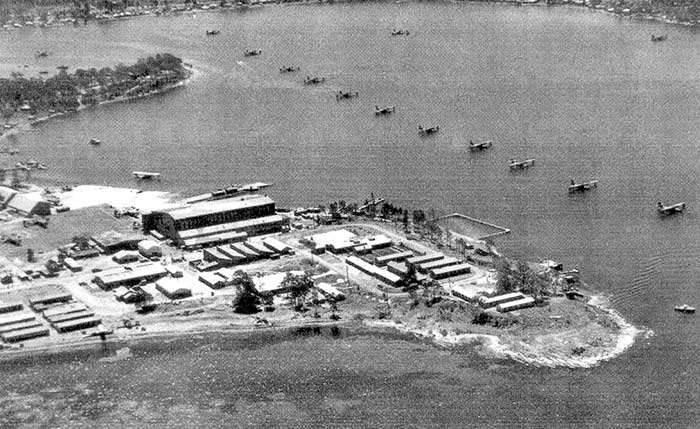
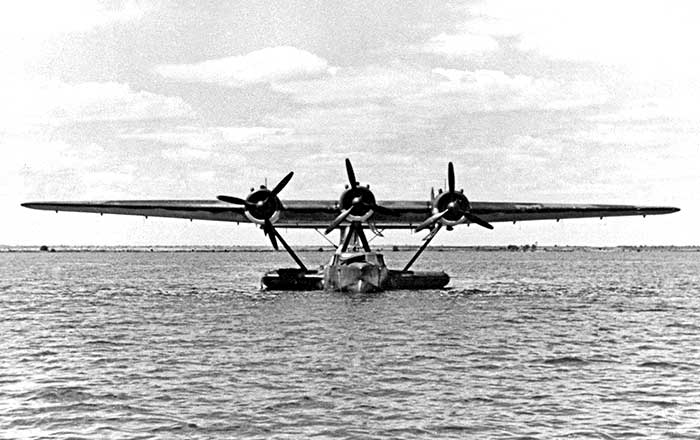

RAAF DORNIER Do 24Ks A49-1 to A49-6
All built by Dornier Werke G.m.b.H at Friedrichshafen, Germany
RAAF Dornier units with their base at the time:
| 9 Sqn | No.9 Squadron, Rathmines NSW |
| 41 Sqn | No.41 Squadron, Townsville Qld |
| 14ARD | No.14 Aircraft Repair Depot, Gorrie NT |
| 8CU | No.8 Communications Unit, Kiriwina, Trobriand Islands, Milne Bay, New Guinea |
| 1FBRD | No.1 Flying Boat Repair Depot, Lake Boga Vic |
| 2FBRD | No.2 Flying Boat Repair Depot, Rathmines NSW |
| 52OBU | No.52 Operational Base Unit, Darwin |
| 3OTU | No.3 Operational Training Unit, Rathmines |
| SHQ | Station Headquarters |
| STF | Seaplane Training Flight, Rathmines |
Dornier Do 24K Werke No.765 X-5, A49-1, "VH-COJ"
| 29.4.42 | Received RAAF at Rathmines as A49-1 ex Netherlands East Indies. Former X-5 |
| 18.5.42 | On strength with RAAF No.9 Squadron |
| 9 Sqn renamed Seaplane Training Flight, Rathmines | |
| 26.6.42 | Allotted Station HQ Rathmines ex STF |
| 7.8.42 | Unserviceable indefinite Rathmines until 11.9.42 |
| 16.9.42 | Swung
to left during water landing at Rathmines and struck ground, seriously
damaging starboard wing and engine, hull holed. Aircraft lifted
by crane on to land. |
| 9.42 | Unserviceable indefinite under repair Rathmines workshops , last weekly report 1.43 |
| Directorate of Air Transport, Allied Air Forces allocated radio callsign VHCOJ. No photo evidence that the callsign was painted externally on the aircraft | |
| 24.6.43 | Received Qantas Empire Airways at Rose Bay flying boat base, Sydney Harbour for inspection ex 2FBRD Rathmines |
| 11.7.43 | Received 2FBRD Rathmines ex QEA |
| 12.7.43 | Allocated to No.41 Sqn |
| 17.10.43 | Received No.41 Sqn. Squadron code "DQ-D" |
| 2.1.44 | Received 1FBRD Lake Boga ex 41 Sqn for urgent hull repairs due split starboard stub-wing fuel tank |
| 27.2.44 | Received No.41 Sqn ex 1FBRD |
| 7.3.44 | Received No.8 Communications Unit, Kiriwina, New Guinea for air sea rescue duties |
| 21.5.44 | Received 1FBRD Lake Boga ex 8CU for storage |
| 20.12.44 | Approval for conversion to components at Lake Boga |
| 29.4.42 | Received RAAF at Rathmines as A49-2 ex Netherlands East Indies. Former X-7 |
| 18.5.42 | On strength with RAAF No.9 Squadron |
| 9 Sqn renamed Seaplane Training Flight, Rathmines | |
| 20.7.42 | Unserviceable indefinite at Rathmines Workshops, last weekly report 4.1.43 |
| 31.7.42 | Received Station HQ Rathmines ex STF |
| Directorate of Air Transport, Allied Air Forces allocated radio callsign VHCOK. No photo evidence that the callsign was painted externally on the aircraft | |
| 13.2.43 | Received 3OTU ex 2FBRD Rathmines |
| 41 Sqn pilot Philip
Matheson did his Dornier training flights at Rathmines early 1943 in
A49-2 which he recalls was the first made operational at Rathmines | |
| 24.5.43 | Received 2FBRD Rathmines ex 3OTU for fuel tank repairs |
| 30.10.43 | Received 41 Sqn ex 2FBRD. Squadron code "DQ-E" |
| 21.11.43 | Received 2FBRD ex 41 Sqn for repair of hull leak near engineers compartment. 41 Sqn state that this aircraft was u/s when received from 2FBRD the previous month |
| 25.6.44 | Received 1FBRD Lake Boga ex 2FBRD for storage |
| 25.6.44 | 1FBRD Operations Record Book: A49-2 arrived Lake Boga, F/O Dudley Wright. All five surviving RAAF Dornier Do 24s are withdrawn from service here. |
| 20.12.44 | Approval for conversion to components at Lake Boga |
| 29.4.42 | Received RAAF at Rathmines as A49-3 ex Netherlands East Indies. Former X-8 |
| 18.5.42 | On strength with RAAF No.9 Squadron |
| 9 Sqn renamed Seaplane Training Flight, Rathmines | |
| 31.7.42 | Received Station HQ Rathmines ex STF |
| 7.8.42 | Unserviceable indefinite at Rathmines Workshops, last weekly report 28.8.42 |
| 2.9.42 | Received 1FBRD Lake Boga ex Rathmines |
| 1 FBRD Operations Record Book 2.9.42: A49-3 under command of Sqn Ldr Gordon Stilling and A49-5 arrived together at Lake Boga, flying time 4 hours 20 minutes from Rathmines. A49-3 was first to land on Lake Boga These were the first Dorniers received at the unit, which mostly handled Catalinas | |
| No beaching gear was available for the Dorniers at 1FBRD at first, so two water-filled trenches were dug into the lake foreshore at RAAF Lake Boga to accomodate each aircraft's bow and sponsons. This allowed maintenance personnel to access the aircraft.Later as buildings and hangars were constructed on the base, Dorniers were beached and moved to hangars for repairs under cover. | |
| 18.9.42 | Unserviceable indefinite at 1FBRD, last report 12.5.43. |
| Directorate of Air Transport, Allied Air Forces allocated radio callsign VHCOL. No photo evidence that the callsign was painted externally on the aircraft | |
| 6.43 | Overhaul completed, had taken 9 months due many difficulties encountered |
| 6.43 | A49-3 first test flight at Lake Boga, flown by Sqn Ldr Geoff Marshall,
1FBRD CO, carrying 9 maintenance personnel. |
| 4.6.43 | 4
hr 25 min test flight by Sqn Ldr Bryan
Monkton of 41 Sqn. Also on board were squadron
maintenance personnel who had been training and working on the Dorniers
at Lake Boga, Sgts Emes, McKnight, Canny, Cpl Aubin and LAC Dyring. |
| 9.6.43 | Departed
Rathmines after an overnight stop en route Townsville. Sqn Ldr Monkton
left Rathmines carrying 12 personnel and 2,600 lbs of freight.. |
| 10.6.43 | Received 41 Sqn ex 1FBRD. Squadron code "DQ-F" |
| 7.43 | 41 Sqn CO grounded A49-3 and A49-5 because electrical faults were a fire risk. Both were ferried back to 1FBRD Lake Boga |
| 11.7.43 | Received 1FBRD ex 41 Sqn for inspection |
| 9.9.43 | Received 41 Sqn ex 1FBRD |
| 11.10.43 | 41 Sqn requests allocation to 1FBRD for 240 hour inspection, engine change and repairs to stub wings |
| 2.12.43 | Hull leak sprung on landing, taking on 5 gallons of water per hour |
| 7.12.43 | Received 1FBRD ex 41 Sqn |
| 25.12.43 | Received 41 Sqn ex 1FBRD |
| 10.2.44 | Received 8CU Kiriwina, New Guinea ex 41 Sqn for air-sea rescue duties |
| 7.3.44 | Returned to 41 Sqn. Request allocation to 1FBRD for 240 hour inspection, engine change |
| 12.3.44 | Received 1FBRD ex 41 Sqn |
| 24.4.44 | To be held in storage at 1FBRD |
| 20.12.44 | Approval for conversion to components at Lake Boga |
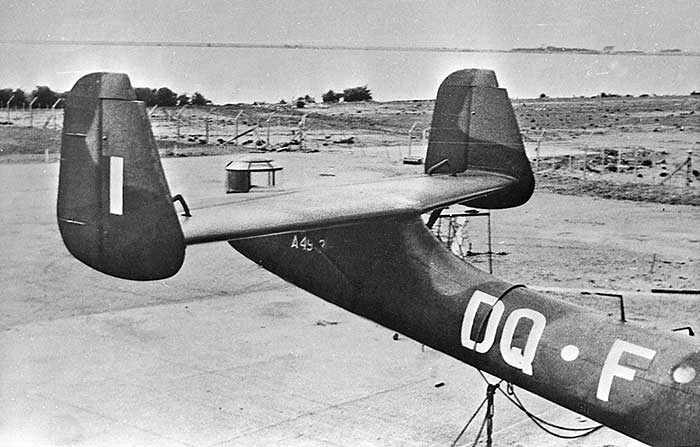
| 29.4.42 | Received RAAF at Rathmines as A49-4 ex Netherlands East Indies. Former X-9 |
| 18.5.42 | On strength with RAAF No.9 Squadron |
| 9 Sqn renamed Seaplane Training Flight, Rathmines | |
| 20.7.42 | Unserviceable indefinite at Rathmines Workshops, last weekly report 18.9.42 |
| 31.7.42 | Allotted SHQ Rathmines ex STF |
| 25.9.42 | Received 1FBRD Lake Boga ex Rathmines |
| 25.9.42 | 1FBRD Operations Record Book: A49-4 and Catalina A24-26 arrived, landing on Lake Boga |
| 25.9.42 | Estimated ready in 3 weeks at 1FBRD |
| 2.10.42 | Unserviceable indefinite at 1FBRD, last weekly report 4.1.43 |
| 12.5.43 | Serviceability depends on replacements for fuel tanks |
| 28.7.43 | Pilot log book: W/Cdr G.D.Marshall (CO 1FBRD): A49-4 further test flight Lake Boga, 9 crew on board |
| 5.8.43 | Received 41 Sqn ex 1FBRD. Squadron code "DQ-G" |
| 8.43 | Log book: Philip Matheson 41 Sqn: flew A49-4 operationally from Townsville |
| Directorate of Air Transport, Allied Air Forces allocated radio callsign VHCOM. No photo evidence that the callsign was painted externally on the aircraft | |
| 8.9.43 | Received 1FBRD ex 41 Sqn for 240 hourly inspection |
| 19.10.43 | 1FBRD Operations Record Book: A49-4 departed Lake Boga, pilot F/Lt Fletcher |
| 20.10.43 | Received 41 Sqn ex 1FBRD |
| 21.10.43 | Log A49-4 VHCOM: flew Townsville-Port Moresby-Townsville, Sqn Ldr Hampshire |
| 23.10.43 | Log: flew Townsville local 40 minutes, pilot Flt Lt Fletcher |
| 24.10.43 | Log: flew Townsville-Port Moresby-Townsville, pilot Flt Lt Fletcher |
| 27.10.43 | Log: flew Townsville-Cairns-Port Moresby, pilot Flt Lt Fletcher |
| 28.10.43 | Log: flew Port Moresby-Townsville, pilot Flt Lt Fletcher |
| 31.10.43 | Log: flew Townsville-Port Moresby-Townsville, pilot Flt Lt Fletcher |
| 23.11.43 | Received 1FBRD ex 41 Sqn for 240 hourly inspection |
| 4.44 | Received 41 Sqn ex 1FBRD |
| 8.4.44 | Received 1FBRD ex 41 Sqn for storage |
| 20.12.44 | Approval for conversion to components at Lake Boga |
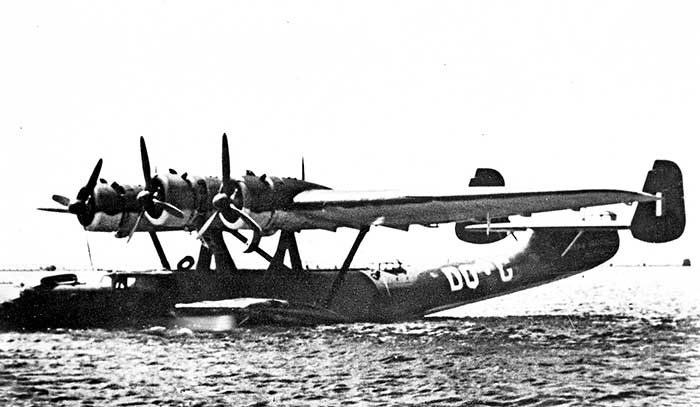
| 29.4.42 | Received RAAF at Rathmines as A49-5 ex Netherlands East Indies. Former X-10 |
| 18.5.42 | On strength with RAAF No.9 Squadron |
| 9 Sqn renamed Seaplane Training Flight, Rathmines | |
| 20.7.42 | Unserviceable indefinite at Rathmines Workshops, last weekly report 28.8.42 |
| 31.7.42 | Received SHQ Rathmines ex STF |
| 2.9.42 | Received 1FBRD Lake Boga ex Rathmines |
| 2.9.42 | 1 FBRD Operations Record Book: A49-5 under command of FO Norm Fader and A49-3 arrived together at Lake Boga, flying time 4 hours 20 minutes from Rathmines. A49-5 landed second on Lake Boga. These were the first Dorniers received at the unit, which mostly handled Catalinas |
| No beaching gear was available for the Dorniers at 1FBRD at first, so two bays were dug into the lake foreshore at RAAF Lake Boga to accomodate each aircraft's bow and sponsons. This allowed maintenance personnel to access the aircraft. Later as buildings and hangars were constructed on the base, Dorniers were beached and moved to hangars for repairs under cover. | |
| 18.9.42 | Unserviceable indefinite at Lake Boga, last weekly report 4.1.43 |
| Directorate of Air Transport, Allied Air Forces allocated radio callsign VHCON. No photo evidence that the callsign was painted externally on the aircraft | |
| 12.5.43 | Estimated serviceable by 29.5.43 |
| 6.43 | A49-3 & -5 overhauls completed, had taken 9 months due many difficulties encountered |
| 12.6.43 | A49-5 first test flight at
Lake Boga, flown by Sqn Ldr Geoff Marshall, 1FBRD CO, carrying 16
maintenance personnel. Aircraft was camouflaged with squadron
code "DQ-H"in white |
| 6.43 | Ferried Lake Boga to Townsville on delivery to 41 Sqn by Flt Lt Webber |
| 7.43 | 41 Sqn CO grounded A49-5 and A49-3 because electrical faults were a fire risk. Both were ferried back to 1FBRD Lake Boga |
| 27.6.43 | Received 41 Sqn ex 1FBRD |
| 14.7.43 | Received 1 FBRD ex 41 Sqn for inspection report |
| 26.9.43 | Received 41 Sqn ex 1FBRD |
| 30.9.43 | Damaged at Cairns by refuelling barge, plating buckled on port side |
| 4.10.43 | Received 1 FBRD ex 41 Sqn for hull repairs |
| 11.10.43 | Received 41 Sqn ex 1FBRD |
| 11.11.43 | Received 1 FBRD ex 41 Sqn for 240 hourly inspection |
| 11.43 | 1FBRD
Operations Record Book: During November 1943 a total of 14 aircraft
arrived: Catalinas, Dornier and Mariners. Four had been completed and
departed. |
| 12.12.43 | 1FBRD ORB: A49-5 departed Lake Boga on ferry to 41 Sqn, pilot F/O Wright |
| 15.12.43 | Received 2FBRD Rathmines ex 1FBRD enroute to 41 Sqn |
| 22.12.43 | Received 41 Sqn ex 1FBRD via 2FBRD |
| 11.1.44 | Received Darwin Detachment. Assigned to No.52 Operational Base Unit, Darwin |
| 11.3.44 | Burnt out by electrical fire and sank at moorings Darwin Harbour NT Two electricians LAC B. C. Hocking and LAC J.L.Viggers and the Wireless Operator/Air Gunner F/Sgt Wall were on board working on a radio wiring fault when the fire broke out. All three escaped but sustained serious burns. James Viggers died in hospital five days later. |
| 14.3.44 | Allotted 14ARD, Gorrie NT for conversion to components. Valueless residue to be destroyed |

Photos:John Hopton Collection
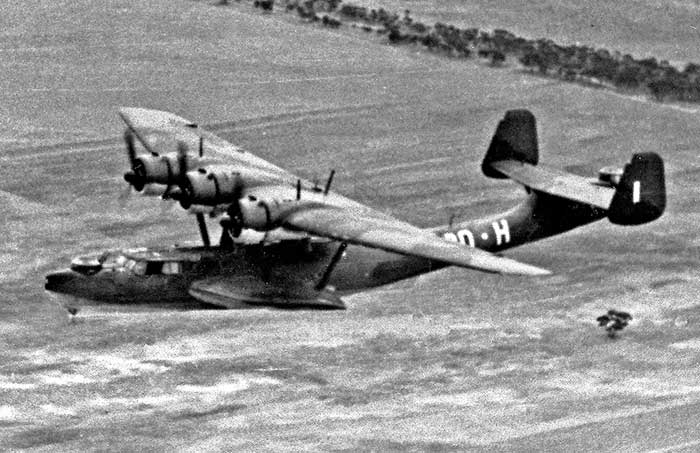


forward on rails to provide an open hatch. Photo: Australian War Memorial

| 8.3.42 | Departed NEI as the final Dornier evacuation flight to Australia. Low on fuel, landed on the WA coastline near Wallal, 200 miles south of Broome. After refuelling, X-24 was flown to Perth and then Rathmines |
| 29.4.42 | X-24 received by RAAF at Rathmines ex Netherlands East Indies. Allocated serial A49-6 |
| 18.5.42 | Held in storage at Rathmines for NEI Government |
| 8.6.42 | RAAF Status Card: Issued to Netherlands East Indies Government |
| X-24
and Catalina Y-45 were initially at Rose Bay civil flying boat base,
Sydney as a clandestine unit operating for the Dutch Intelligence Service. The unit, which was under the command of MLD First Lieutenant Aernout, was originally named Aernout Group (Groep Aernout), later changed to Detachment MLD in Australia. | |
| 9.6.42 | X-24
at Groote Eylandt NT flying boat base, outbound from Rathmines carrying
Captain of the General Staff (S.H.Spoor) on tour of Dutch territory not
occupied by the Japanese. |
| X-24
flew to Saumlaki, Toeal, Merauke, Tanah Merah, Bernhard Kamp, Tanah
Merah, Merauke, Exchange Lakes, Merauke then Townsville where arrived
15.6.42. | |
| 16.6.42 | X-24 arrived Sydney via Brisbane, Rathmines. |
| 7.42 | X-24 initial return trip from Sydney to Townsville, Karumba, Horn Island, Bernhard Kamp, Tanah Merah, Merauke, Karumba, Townsville, Sydney |
| 11.8.42 | X-24 departed Sydney on return flight to Merauke, Netherlands New Guinea |
| 10.42 | X-24 operated on "secret missions" |
| X-24 Flight Engineer Corporal Harry "Henk" Gryzen later wrote: "After a couple of trips we were able to replace the Dornier with a brand new Catalina* which was greatly appreciated by the entire crew. Our Dornier missions were to fly military personnel and supplies to Merauke, Digul and Wessel Lakes in Dutch New Guinea. These areas were still under Dutch administration and no Japanese activity was observed at this time. When we were due for our 240 hour engine overhaul, we were ordered to Lake Boga." *Y-87 delivered to Rose Bay new from USA in May 1943. | |
| 15.4.43 | Dornier X-24 arrived at Lake Boga. Aircraft was in Dutch markings, flown by NEI crew: Captain: First Lieutenant Aernout Second Pilot: Sgt De Vries Navigator: Lt. Juta Flight Engineer: Cpl Harry Gryzen |
| 5.43 | X-24
flown locally from Lake Boga by MLD Captain Aernaut to familiarise RAAF
Sqn Ldr Geoffrey D. Marshall (1 FBRD CO) on the Dornier. This was to
assist Marshall who was required to test fly Dorniers A49-3 and A49-5
which were nearing completion of their overhauls at 1FBRD. |
| 8.6.43 | Official date transferred to RAAF ex NEI Government. Taken on charge as A49-6 |
| 8.11.43 | Received Qantas Empire Airways, Rose Bay Flying Boat Base, Sydney for inspection |
| 9.11.43 | 2FBRD Detachment at Rose Bay to take this aircraft on charge under identification A49-6 and issue to QEA Rose Bay for installation of centre engine and application of markings and identification number |
| 14.5.44 | Received 1FBRD Lake Boga for storage ex Qantas Rose Bay |
| 20.12.44 | Approval for conversion to components at Lake Boga |
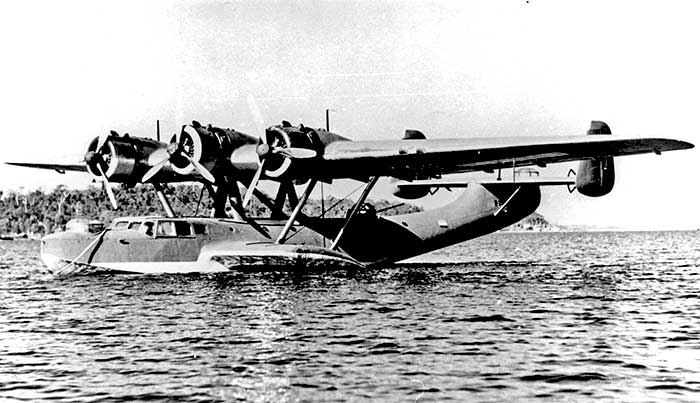
red, white and blue rectangle. Note the canon in the fuselage top turret. Photo: Frank F. Smith collection

with covers over all three engines and cockpit area. Photo: John Hopton Collection
After RAAF disposal - a Dornier houseboat
In the first half of 1944 the five remaining RAAF Dornier Do 24s
were
flown to 1FBRD at Lake Boga where they were hauled up on land and left
in a group
alongside the lake. On 20 December RAAF HQ instructed
that their storage was no longer necessary and they should be converted
to components and the remainder disposed of. Being all-metal airframes,
after engines and useable parts had been removed, they were sold to
scrap metal dealers.
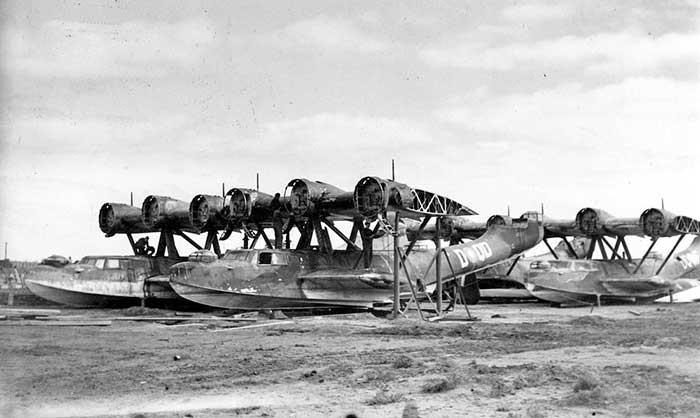
A49-1 is in the foreground with incorrect application of its code DQ-D, with A49-6 on its right, still in MLD scheme
because it was used by NEI Intelligence for secret missions back to NEI and never used operationally by RAAF.
Photo: State Library of Victoria
The Dornier housboat was sold to Hank Horsefall at Echuca in 1954 and was seen at various locations along the River Murray for many years. By September 1976 it was ashore at Echuca on its boat trailer, with all paint removed and the cockpit windows smashed by vandals In 1988 it was acquired by Gary Wood of Echuca who carried out an external restoration and repainted it green and white. A few year later it was repainted overall cream with the name Dornier on the bow. By 1999 was on vacant land, parked on its trailer behind the RSL Club at Moama, just across the River Murray bridge from Echuca. The interior retained many aircraft hull features but fittings and seats were ruined by the effects of weather egress. The Dornier houseboat was to languish in that spot at Moama until 2010 when it was acquired by the Lake Boga Flying Boat Museum.
This last relic of the RAAF Dornier Do 24s was moved to Lake Boga where museum volunteers have been working on it at a nearby property, painting it dark green to approximate wartime camouflage. The museum is established on the site of the Lake Boga RAAF Station and the underground communications centre has been re-opened. A large hangar has recently been built to cover the museum's Catalina, a composite assembled from Catalina sections salvaged from local farms, painted as RAAF "A24-30".

All external paintwork had been removed for a new scheme. Photo by Nigel Daw
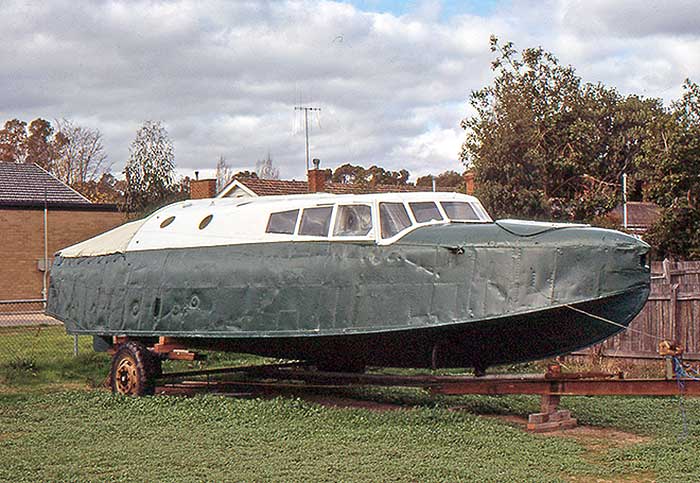
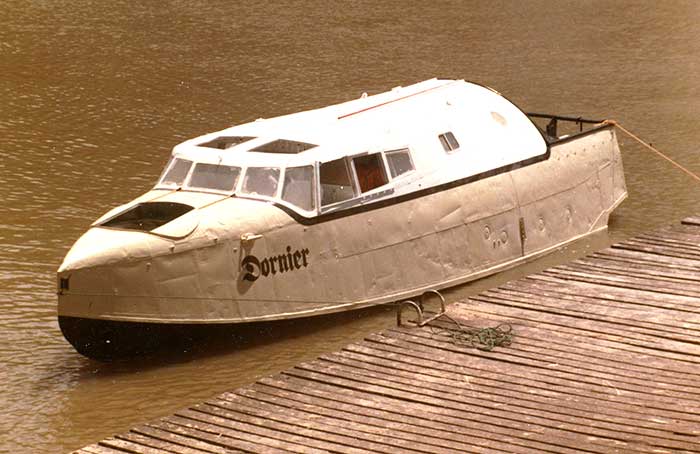
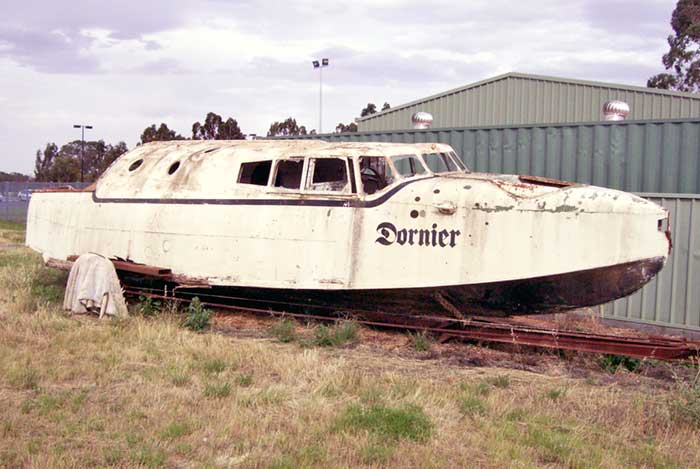
the cockpit windows had been vandalised and the interior was derelict. Photo by Martin Edwards
- LAKE BOGA DISPOSALS
- KIMBERLEY WAR RELICS
- RAAF Airframe Record Cards, A49- series: RAAF Historical Section, Canberra
- Pacific Island Aviation Society notes on NEI military history, compiled by Alan Bovelt
- Australian Transport Aircraft Callsigns, compiled by Alan Bovelt 26.4.93
- The Boats I Flew, Brian Monkton, Australian Aviation Museum, Bankstown, 2005
- Lake Boga At War, Brett Freeman, Catalina Publications 1995
- Flypast - A Record of Aviation In Australia, Neville Parnell & Trevor Boughton, AGPS 1988
- Australian Air Force since 1911, N.M.Parnell & C.A.Lynch, Reed 1976
- Units of the RAAF, Vols. 1 to 7, RAAF Historical Section, Canberra 1995
- The Dornier Do 24K In The East Indies, Colin Owers, Aviation News, October 1991
- East Indies Catalinas, Paul Jackson, Aviation News magazine
- Enemy and Ally, David Wilson RAAF Historical Section, Wings magazine Autumn 1986
- WA's Pearl Habour, The Japanese Attack of Broome, Mervyn W. Prime, RAAFA Museum, Perth
- Blitz on Broome, Mervyn Prime, Flightpath magazine, 1994
- Hans de Vries, recollections of a MLD pilot, Aerogram journal, March 2010
- ADF Serials website
- Australia at War website: www.ozatwar.com
- Phil Vabre: research on flying boat facilities at Darwin
- Pilot log book extract, Flt Lt Fletcher 41 Squadron, courtesy David Vincent
- Dornier X-24 operations June 1942-43: Dutch National Archives, courtesy Coen van den Heuvel
- Dornier Details, F. Gerdessen, Letter to Editor, Air Enthusiast magazine, June 1972
- Air Raid on Broome, Stan Gajda, After The Battle magazine, March 1980
- Diamonds are (Missing) Forever, James Henderson, Australian Playboy magazine, November 1979
- Dutch Dorniers Investigated, Western Airletter monthly newsletter, Perth, February-March 1982: Stan Gajda's Broome investigations
- Broome's day of death, West Australian newspaper, Perth 2 March 1983 (this feature article even misquotes the date of the raid!)
- Stan Gajda: ongoing correspondence and photographs. Thank you Stan.